Author: Adam Simmons
Date published: September 30th 2021
Table of Contents
Introduction
Corsair are best known for their gaming peripherals, PCs and components. The 32QHD165 marks their first foray into the world of gaming monitors as part of their XENEON sub-brand. The monitor is designed for an immersive but responsive gaming experience, whilst providing good capability for productivity-oriented tasks as well. It offers a 32” screen size, IPS (In-Plane Switching) type panel and 165Hz refresh rate. It provides additional attractive features such as Adaptive-Sync (including AMD FreeSync Premium), a generous colour gamut and HDR10 support via VESA DisplayHDR 400. We put this model through its paces in our usual testing suite.
Specifications
The monitor is based around a 32” AU Optronics AHVA (Advanced Hyper-Viewing Angle) IPS-type panel. This supports true 8-bit colour, a 165Hz refresh rate and 2560 x 1440 (WQHD) resolution. A 1ms grey to grey response time is specified, but as usual approach with caution. Some of the key ‘talking points’ for this monitor have been highlighted in blue below, for your reading convenience.
*10-bit can be selected in the graphics driver at up to 120Hz when using DP and running at the native resolution. 10-bit and 12-bit can be selected at up to 60Hz when using HDMI. The panel used is only an 8-bit panel, but the monitor’s scaler can add a dithering stage to facilitate work with higher bit depth content.
As an Amazon Associate I earn from qualifying purchases made using the below link. Where possible, you’ll be redirected to your nearest store. Further information on supporting our work. The monitor has a unique look, accentuated by the distinctively styled stand base. This base and the neck of the stand are die-cast aluminium with a dark grey finish, giving a weighty and premium feel to things. This model has one of the heftiest and most solid stands we’ve come across on a monitor, almost like this thing is part monitor part military aircraft. The bottom bezel is black with a blended Corsair Sails logo in the middle. It’s reasonably slim at ~18mm (0.71 inches) with just a sliver of panel border visible. The top and side bezels are dual-stage with a slim panel border flush with the rest of the screen and a slender hard plastic outer part. Including both components, the bezels are ~10mm (0.39 inches). The large screen naturally dominates from the front, with a very light matte anti-glare finish – both factors are explored deeper into the review. The OSD (On Screen Display) is controlled by a joystick at the rear of the monitor, towards the right side as viewed from the front. There’s a dedicated power button above the joystick, with a power indicator LED towards the right side of the bottom bezel. This glows a gentle white when the monitor is switched on (can be disabled in the OSD) or dark orange when signal to the system is lost and it enters a low power state. The video below runs through the OSD as well as Corsair’s iCUE software which can be used to control it. The monitor is identified here by an alternative model code used by the manufacturer; ‘RDD0013’. This may just be how things are reported on our pre-release sample, retail samples may or may not be reported with this code. The image below is a macro photograph taken on Notepad with ClearType disabled. The letters ‘PCM’ are typed out to help highlight any potential text rendering issues related to unusual subpixel structure, whilst the white space more clearly shows the actual subpixel layout alongside a rough indication of screen surface. This model uses a very light matte anti-glare screen surface, offering reasonable glare handling. In somewhat brighter conditions, with light striking the screen surface directly, you may notice a ‘glassy’ appearance when observing darker content in particular. Because light emission from the screen is more direct than on more aggressive matte surfaces, clarity and vibrancy is better preserved without a layered appearance in front of the image. The screen surface texture is relatively smooth, with a light ‘misty’ graininess observed when viewing lighter content but not a ‘heavy’ or ‘smeary’ graininess. Most users will find this level of graininess unobtrusive or won’t really notice it. The 32QHD165 includes various ‘Preset’ modes; ‘Standard’, ‘Movie’, ‘Text’, ‘sRGB’, ‘Creative’ and ‘Game’. With the exception of ‘sRGB’, these simply have various settings in the OSD set to different values by default. So they don’t achieve anything you couldn’t achieve with manual adjustments. They are useful in that they will remember most adjustments you make in the ‘Picture’ section of the menu, allowing you to have various sets of custom settings. Manual adjustments to colour channels (‘Color Temperature = Custom’) are applied universally and aren’t specific to each preset, however. We appreciate the simplicity and flexibility of this preset system compared to presets which lock off your settings or fail to recall changes made when using them. For the table below we focus on a range of manual adjustments in the OSD. Gamma and white point readings are provided, taken using a Datacolor SpyderX Elite colorimeter as are general observations. Our test system uses Windows 10 with an Nvidia RTX 3090 connected using the supplied DisplayPort cable. Additional testing was performed using an AMD Radeon RX 580 and using HDMI, although observations for this table didn’t vary significantly between GPUs or inputs. No additional monitor drivers or ICC profiles were specifically loaded and the monitor was left to run for over 2 hours before readings were taken or observations made. The monitor was set to 165Hz in Windows, although that didn’t significantly affect the readings or observations in this table. When viewing the figures in this table, note that for most PC users ‘6500K’ for white point and ‘2.2’ for gamma are good targets to aim for. Individual targets depend on individual uses, tastes and the lighting environment, however.
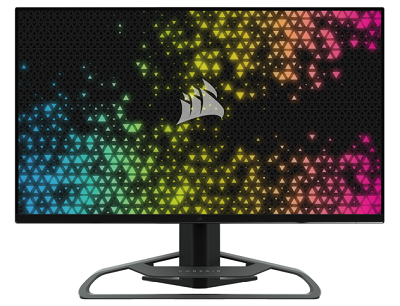
Features and aesthetics

From the side the screen is slender at thinnest point, ~17mm (0.67 inches). It has more central bulk, towards the stand attachment point. The included stand offers tilt (5° forwards, 20° backwards), swivel (30° left, 30° right) and height adjustment (110mm or 4.33 inches). At lowest stand height the screen clears the desk by ~70mm (2.76 inches) with the top of the screen ~500mm (19.66 inches) above the desk. The total depth of the monitor including stand is ~316mm (12.44 inches), with the screen ~75mm (3 inches) back from the front edge of the stand. So the stand is quite hefty and takes up a fair bit of desk space, though the screen isn’t forced as close to the face as some large stand designs. Which allows you to keep a reasonable distance between your eyes and the screen unless your desk is quite shallow.

The rear of the monitor is mainly matte black plastic, with a glossy black plastic Corsair Sails logo at the top. Beneath this there are some ventilation holes, with the stand attaching centrally via 100 x 100mm VESA. It can be replaced by an alternative VESA 100 compatible solution, if preferred. The stand neck is die-cast aluminium and includes an adjustable ‘RapidRoute’ cable management system. Small detachable clips you can feed cables through and can slide up and down the stand neck to your desired position. Two additional clips are included in the box, which are around twice as tall as the ones pre-attached to the stand. The top of the stand includes a camera mounting screw point. The ports face downwards and include; a 3.5mm headphone jack, 2 HDMI 2.0 ports, DP 1.4, USB-C (15W PD, DP Alt Mode, USB 3.1 upstream data), USB-C 3.1 upstream, 2 USB 3.1 ports and DC power (external ‘power brick’).


The full capability of the monitor including 2560 x 1440 @165Hz plus HDR and Adaptive-Sync can be leveraged via DP 1.4, including AMD FreeSync Premium and Nvidia’s ‘G-SYNC Compatible Mode’. HDMI 2.0 is limited to 144Hz and supports AMD FreeSync Premium but not Nvidia’s ‘G-SYNC Compatible Mode’. A power cable and adaptor, USB-C cable, HDMI 2.0 cable and DP cable is included as standard. The images below show the refresh rates supported for the native 2560 x 1440 (WQHD or 1440p) resolution via DP (top image) and HDMI (bottom image).


The images below show the refresh rates supported when running in the 1920 x 1080 (Full HD or 1080p) resolution using DP. The first image shows the resolutions categorised in the EDID of the monitor as ‘TV resolutions’ and listed here under ‘Ultra HD, HD, SD’. The second image shows resolutions categorised in the EDID and listed here as ‘PC’ resolutions. The same refresh rates are listed via HDMI for the first list. 144Hz rather than 165Hz is listed in the second list. A ‘4k x 2k, 3840 x 2160’ downsampling mode is also included by both DP and HDMI at up to 60Hz, as shown in the third image. Potentially useful for games consoles that don’t support a 2560 x 1440 signal but would accept a 3840 x 2160 signal.


If you’re intending to use the monitor with the PS5 or Xbox Series X/S, be aware that a small settings tweak may be required to ensure 120Hz is selectable for supported resolutions. Details can be found in this article.
Calibration
Subpixel layout and screen surface
![]()
As shown above, the monitor uses the standard RGB (Red, Green and Blue) stripe subpixel layout. This is the default expected by modern operating systems such as Microsoft Windows. Apple’s MacOS no longer uses subpixel rendering and therefore doesn’t optimise text for one particular subpixel layout to the detriment of another. You needn’t worry about text fringing from non-standard subpixel layouts and won’t need to change the defaults in the ‘ClearType Text Tuner’ as a Windows user. You may still wish to run through the ClearType wizard and adjust according to preferences, however. The subpixel layout and arrangement is normal and we had no subpixel-related concerns related to sharpness or text clarity on this model.
Testing the presets
Preset Mode Gamma (central average) White point (kelvins) Notes Gamma = 2.0 2.0 6974K Very vibrant overall, with a bit of a cool tint. A lack of depth in places due to gamma handling with excessive detail in dark areas. Gamma = 2.2 (Factory Defaults) 2.2 6981K As above but more appropriate depth – strong vibrancy and variety. Gamma = 2.4 2.5 6979K As above with extra depth. Quite a striking look, but poor distinctions between dark shades. Color Temperature = Custom 2.2 7446K As factory defaults but a cool tint with additional green push. Color Temperature = Warm 2.2 5412K A fairly effective Low Blue Light (LBL) setting, reducing the blue channel a fair bit and reducing blue light output. Image appears warmer than default. Eye Saver = On 2.2 6194K A mild LBL setting. Somewhat warmer than factory defaults with a bit of blue light reduction, not as effective as ‘Warm’ setting. Slight green tint as green channel remains relatively strong. Warm + Eye Saver 2.2 5043K A combination of the above settings, forming a highly effective LBL setting. Significant blue light reduction with a slight green tint. Your eyes should adjust to this quite readily. Preset = sRGB 2.2 7101K An sRGB emulation setting, clamping gamut closer to sRGB. As explored later there is some under coverage on our unit. The green and red channel is also too weak and blue too strong – image appears somewhat undersaturated overall with this setting. Brightness can be adjusted, some other settings such as colour channels are locked. Test Settings (see below) 2.2 6523K A highly vibrant image but otherwise nicely balanced, with strong variety.
Straight from the box the monitor provided a highly vibrant image with strong saturation, good variety and pleasing consistency. The colour temperature was a touch cool, but gamma tracking adhered well to our preferred target of the ‘2.2’ curve. This is shown in the graph below, with the monitor running our ‘Test Settings’ – gamma tracking was very similar to this using factory defaults. Given the intended uses for monitor, inter-unit variation and strong performance following OSD tweaking alone we will not be using any ICC profiles for this review or including any measurements or graphs using them. We wouldn’t recommend using them unless created for your specific unit using your own calibration device. But we appreciate some users still like to use profiles and some aspects such as gamut mapping for colour-aware applications can be useful. You can download our ICC profile for this model, which was created using our ‘Test Settings’ as a base. You can also download our sRGB profile which was created using and designed for the ‘sRGB’ preset (sRGB emulation setting). Be aware of inter-unit variation and note again that this ICC profile is not used in the review. The monitor also includes a few settings which fill the Low Blue Light (LBL) role; ‘Eye Saver’ and ‘Color Temperature = Warm’. The former had a mild effect and the latter a moderate effect; combing the two provided very effective blue light reduction. This is particularly true if brightness is kept relatively low. Reducing exposure to stimulating blue light in the hours leading towards bed is particularly important to aid a restful night’s sleep. We used both settings together for our own viewing comfort in the evenings, although not for specific testing of the monitor beyond that focused on the settings themselves. The flexible preset system of the monitor made it easy to switch between this setup and our regular ‘Test Settings’. We actually made use of the ‘Text’ preset which was already setup with the ‘Warm’ setting by default, with the ‘Eye Saver’ setting then activated on top. For our ‘Test Settings’ we reduced brightness and made moderate adjustments to colour channels. Note that individual units and preferences vary, so these settings are simply a suggestion and won’t be optimal for all users or units. We’ve also included our preferred ‘Response Time’ setting used for most of the review and the refresh rate used in Windows, just for reference. These settings only apply to SDR, HDR has separate settings associated with it (is far more restrictive) and is explored in the relevant section of the review. Preset: Standard Brightness= 36 (according to preferences and lighting) Color Temperature= Custom R= 100 G= 91 B= 90 Response Time= Normal AMD FreeSync Premium= On Refresh rate (Windows setting)= 165Hz
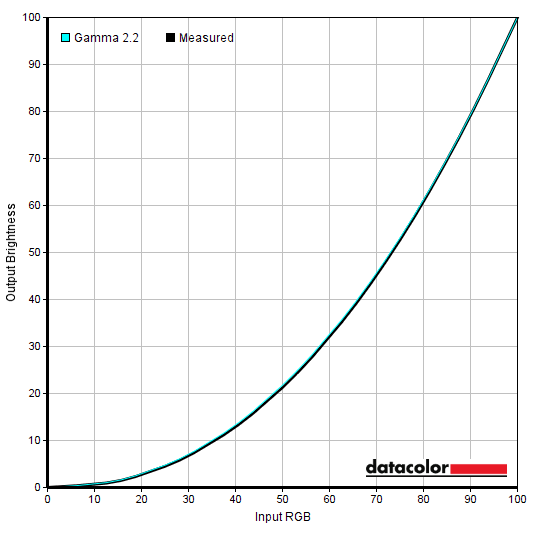
Gamma 'Test Settings'
Test Settings
Contrast and brightness
Contrast ratios
An X-Rite i1Display Pro Plus was used to measure the luminance of white and black using various settings on the monitor, including those covered in the calibration section. From these values, static contrast ratios were calculated. The table below shows these results, with blue highlights indicating the results with HDR active at full brightness and under our ‘Test Settings’. Black highlights indicate the highest white luminance, lowest black luminance and highest contrast ratio. Assume any setting not mentioned was left at default, with the exceptions already noted here or in the calibration section.
| Monitor Settings | White luminance (cd/m²) | Black luminance (cd/m²) | Contrast ratio (x:1) |
| 100% brightness | 398 | 0.41 | 971 |
| 80% brightness | 330 | 0.34 | 971 |
| 60% brightness | 261 | 0.27 | 967 |
| 40% brightness | 190 | 0.20 | 950 |
| 20% brightness | 118 | 0.12 | 983 |
| 0% brightness | 43 | <0.05 | >860 |
| 30% brightness (Factory Defaults) | 155 | 0.16 | 969 |
| HDR* | 401 | 0.40 | 1003 |
| Gamma = 2.0 | 156 | 0.16 | 975 |
| Gamma = 2.4 | 154 | 0.16 | 963 |
| Color Temperature = Custom | 171 | 0.16 | 1069 |
| Color Temperature = Custom (100% brightness) | 441 | 0.41 | 1076 |
| Color Temperature = Warm | 146 | 0.16 | 913 |
| Eye Saver = On | 152 | 0.16 | 950 |
| Warm + Eye Saver | 145 | 0.16 | 906 |
| Preset = sRGB | 151 | 0.15 | 1007 |
| MPRT @165Hz | 122 | 0.13 | 938 |
| MPRT @120Hz | 122 | 0.13 | 938 |
| Test Settings | 173 | 0.18 | 961 |
*HDR measurements were made using this YouTube HDR brightness test video, running full screen at ‘1440p HDR’ on Google Chrome. The maximum reading from the smallest patch size (measurement area) that comfortably covered the entire sensor area and colorimeter housing was used for the white luminance measurement, which was ‘4% of all pixels’ in this case. The black luminance was taken at the same point of the video with the colorimeter offset to the side of the white test patch, equidistant between the test patch and edge of the monitor bezel.
The average static contrast with only brightness adjusted was 968:1, just a touch under the specified 1000:1. The maximum contrast recorded was 1076:1, with all colour channels under their neutral position (‘Color Temperature = Custom’) at full brightness. We recorded 961:1 under our ‘Test Settings’, quite respectable following the moderate adjustments made to colour channels. Using the ‘MPRT’ setting, a fair brightness of 122 cd/m² was recorded – brightness is locked off so you don’t have any flexibility to change that on the monitor with this setting active. No contrast advantage was gained under HDR as the backlight doesn’t offer any local dimming. We recorded a peak luminance of 401 cd/m², similar to SDR with factory defaults but full brightness. Sustained luminance levels were similar to this and not documented. This is a bit shy of the 440 cd/m² specified, but this wouldn’t dramatically change the experience either way. The maximum brightness recorded under SDR was 441 cd/m², with a minimum white luminance of 43 cd/m². This provides a 398 cd/m² luminance adjustment range with fairly low minimum and quite bright maximum.
PWM (Pulse Width Modulation)
The 32QHD165 does not use PWM (Pulse Width Modulation) to regulate backlight brightness at any level. Instead, DC (Direct Current) is used to moderate brightness. The backlight is therefore considered ‘flicker-free’, which will come as welcome news to those sensitive to flickering or worried about side-effects from PWM usage. The exception to this is with ‘MPRT’ active, a strobe backlight setting which causes the backlight to flicker at a frequency matching the refresh rate of the display.
Luminance uniformity
Whilst observing a black background in a dark room, using our ‘Test Settings’, we observed some backlight bleed and clouding. It’s important to note that individual units vary when it comes to backlight bleed and clouding. The image below shows the results on our units, taken a sufficient distance back to eliminate ‘IPS glow’. This is most noticeable towards the bottom corners of the screen, from a normal viewing position. It appears as a slightly cool green-grey haze towards the bottom left and a warm and slightly brown to orange haze towards the bottom right. It ‘blooms out’ from sharper viewing angles with its tint depending on the angle, as demonstrated in the viewing angles video later. The luminance uniformity was variable. The brightest point recorded was ‘quadrant 5’ in the centre of the screen (163.7 cd/m²). The greatest deviation from this occurred at ‘quadrant 3’, towards the top right (136.8 cd/m², which is 16% dimmer). The average deviation between each quadrant and the brightest point was 10%, which is moderate. It’s important to remember that uniformity varies between individual units and you can also expect variation beyond the points measured. The contour maps below show these deviations graphically, with darker greys representing lower luminance and hence greater deviation from the brightest recorded point than lighter greys. Percentage deviations between each quadrant and the brightest point are also given. The SpyderX Elite was also used to analyse variation in the colour temperature (white point) for the same 9 quadrants. The deviation between each quadrant and the quadrant closest to the 6500K (D65) daylight white point target was analysed and a DeltaE value assigned. A DeltaE >3 represents significant deviation that most users could readily notice by eye. The colour temperature uniformity was moderate, with significant deviations recorded towards the left side and top right. The highest deviation was DeltaE 3.5 towards the top left, which is not extreme but still significant. It’s again important to remember that individual units vary when it comes to uniformity and that deviation beyond the measured points should be expected. It’s also worth noting that due to how wide the gamut is, deviation in colour temperature can appear more exaggerated than these sorts of measurements might suggest. When viewing large patches of bright shade such as white, warm regions can appear with more of a reddish tint than you might expect. And cool regions noticeably cool-tinted or slightly greenish in comparison. Our unit was decent in this respect, though we observed some weaknesses in uniformity that were somewhat more pronounced than the measurements might suggest. On Battlefield V the monitor provided a reasonable contrast experience. With a static contrast of 961:1 under our ‘Test Settings’, this was not sufficient to give a deep or atmospheric look to things. This is particularly noticeable if your room lighting is on the dim side. The contrast is still superior to some IPS models, whilst others are marginally stronger – the only real step up in LCD form (without intricate local dimming) would come from a VA model. There was also a moderate amount of ‘IPS glow’, as much if not slightly less than we’d expect to see from an IPS-type panel of this size. This ‘bloom’ which emanates from the corners of the screen eats away at detail and atmosphere. It’s most noticeable lower down the screen from our preferred viewing position, particularly towards the bottom right where it has a cool green-grey tint. But it can be observed further up as well depending on viewing position. Sitting closer to the screen, using a higher brightness or for units that suffer significant clouding or backlight bleed it can be brought out more strongly. The screen surface imparted a ‘misty’ graininess when observing lighter content. Rather than a heavy or smeary appearance – and without a layered appearance in front of the image. The experience was similar on Shadow of the Tomb Raider. With many dark caves, dim interiors and other heavily shaded areas this title really benefits from a strong contrast experience. In this respect the reasonable but far from amazing contrast experience here didn’t really provide a strong depth and atmosphere or provide strongly defined shadow detailing. Particularly in a dim room. The moderate amount of ‘IPS glow’ further subdued the atmosphere peripherally. But on both test titles, a definite advantage with this model’s IPS-type panel is the strong gamma consistency. Dark details are maintained better throughout the screen compared to VA or TN models. ‘IPS glow’ does affect this in some regions, but there isn’t a defined vertical shift as you see on TN models or central ‘black crush’ centrally and excess detail peripherally as associated with VA models. Brighter content again had a slight ‘misty’ graininess to it, less noticeable than on most matte surfaces and without the layered appearance you sometimes get in front of the image as well. We also made contrast observations using the film Star Wars: The Rise of Skywalker. This is another title which benefits from a strong contrast performance, with many ‘high-contrast’ scenes. Bright pulses of energy, fire, light sabers and suchlike lighting up otherwise dark environments are commonly observed. The monitor didn’t provide a very cinematic experience here, particularly in a dim room – but this is entirely what we’d expect given the IPS-type panel. ‘IPS glow’ was again a feature and because this film had black bars at the top and bottom (‘letterboxing’), these weaknesses were quite apparent. Most content on platforms including YouTube and Netflix are presented with a 16:9 aspect ratio and won’t have these bars, however. The strong gamma consistency was again a benefit, as was the screen surface which provided only a misty graininess and allowed relatively direct light emission for a matte surface. The Lagom tests for contrast allow specific weaknesses in contrast performance to be identified. The following observations were made in a dark room. The monitor uses a Quantum Dot (QD) backlight solution to enhance the gamut, employing blue LEDs coated by a layer of red and green Quantum Dots. This creates much larger peaks of green and red light than you’d see on your typical standard gamut monitor. These strong green and red peaks enhance the colour gamut whilst also creating a more balanced and less blue-biased spectral profile, potentially aiding viewing comfort. The Corsair 32QHD165’s colour gamut (red triangle) was compared with the sRGB (green triangle) and DCI-P3 (blue triangle) reference colour spaces using our ‘Test Settings’, as shown in the first image below. The gamut fully covers sRGB with significant extension beyond that. We measured 95% DCI-P3 coverage, with slight extension beyond for some red shades and significant extension beyond in the green to blue region of the gamut. The second image shows the monitor’s colour gamut (red triangle) compared to Adobe RGB (purple triangle). We recorded 100% Adobe RGB coverage with some extension beyond, particularly in the red region. This gamut is very generous, so for standard sRGB content outside of a colour-managed environment there’s a significant amount of extra vibrancy and saturation. The monitor also offers an sRGB emulation setting, the ‘sRGB’ preset. This clamps the colour gamut closer to sRGB – brightness can be adjusted but quite a few other settings including ‘Gamma’ and colour channels are locked off. Using this setting we recorded some under-coverage but no recorded over-extension (96% coverage), as shown below. This setting is useful for more faithful representation of content within the sRGB colour space even in non colour-managed applications and without profiling of the monitor. Although the under-coverage (can vary between units) and lack of flexibility isn’t ideal. To maximise colour accuracy within the sRGB colour space, for colour-managed workflows, full calibration and profiling with a colorimeter or similar device using the full native gamut is recommended. The generous DCI-P3 and Adobe RGB coverage would also make the monitor suitable for work within those wider colour spaces. You may try the ICC profile featured in the calibration section which includes gamut mapping for colour-aware applications, but best results are always obtained by calibrating your own unit with your own hardware. Instead of using this ‘sRGB’ setting and putting up with the associated restrictions, AMD users can activate a flexible sRGB emulation setting via the graphics driver. This is done by opening ‘AMD Radeon Software’, clicking ‘Settings’ (cog icon towards top right) and clicking on ‘Display’. You should then ensure that the ‘Custom Color’ slider to the right is set to ‘Enabled’ and ‘Color Temperature Control’ set to ‘Disabled’. It may appear to be set this way by default, but the native rather than restricted gamut is likely in play. If that’s the case, simply switch the ‘Color Temperature Control’ slider to ‘Enabled’ then back to ‘Disabled’ to leverage the sRGB emulation behaviour. This setting is shown in the image below. The gamut below shows results using our ‘Test Settings’ with this driver tweak applied. The colour gamut now covers 98% sRGB with no real extension beyond. This setting offers reasonable tracking of sRGB and helps to cut down on the colour gamut without profiling, including in applications that aren’t colour managed. It offers more complete coverage than the sRGB emulation setting did on our unit, too. And you don’t have to put up with restrictions associated with the monitor’s sRGB emulation setting. Remember not to use this tweak under HDR, though, or the image will appear significantly oversaturated. The monitor gave a very vibrant look to shades on Battlefield V. As usual for typical content viewed under SDR, this game is designed with the sRGB colour space in mind. If the monitor’s gamut extends beyond that – which is does in this case, significantly – things become more strongly saturated. Unlike a boost to digital saturation, for example increasing ‘Saturation’ in the OSD or increasing an alternative saturation slider in the graphics driver, the shade range and variety is maintained appropriately. These digital saturation boosts pull shades closer to the edge of the gamut without expanding the gamut itself, so the most saturated shades remain at the same level and there’s less of a gap between those and shades that should be more muted. Red-biased shades had their red components brought out in a very vivid way. Flames, for example, showed some very deep oranges that verged on red. And earthy browns often looked less neutral than intended with a rich red cast. Extension in the gamut in the green region and its green to blue edge is particularly strong. This made some green shades including for vegetation look somewhat neon at times and yellowish greens had their yellows brought out too strongly. Sky blues were often rather striking as well. There were some impressively lush and deep looking forest greens in places, though. Shadow of the Tomb Raider provided similar unmistakable vibrancy. Sky blues were particularly vivid in places, looking more saturated than the developers intend. The reddish hues being brought out too strongly affected the neutrality of earthy browns and woody tones, whilst also making some skin tones such as Lara’s own visage appear somewhat too tanned (or slightly sunburnt). There were again some very lush-looking forest greens, but some shades verged a bit on the neon end and yellowish greens had their yellow components brought out too strongly. Things certainly appeared vibrant, which will appeal to some – less as the developers intend. For those who prefer a more toned-down look things that’s closer to the developer’s original intentions, the sRGB’ preset (sRGB emulation setting) mentioned earlier or the GPU-level ‘fixes’ would be worth exploring. Whichever path you choose with this monitor, the strong colour consistency from the IPS-type panel helps maintain that level of richness and vibrancy well throughout the screen. You don’t get the saturation losses or jumps in shade depth that occur on TN or VA models depending on where on the screen you’ve observing a given shade. Observations were also made on the TV series Futurama, which is a particularly unforgiving test for colour consistency due to large areas of individual shade. The monitor performed well here, without clear saturation shifts as you’d observe on TN or VA models. And superior consistency compared to some IPS-type models of this size, too. Shade representation was highly vibrant overall, with strong saturation giving a lively look to things. There were plenty of very eye-catching neon shades, such as pinks, greens and oranges. Excellent depth to shades such as deep purples, greens and reds. And strong shade variety – though pastel shades certainly appeared less muted than they should, as they shared in this uplifted saturation. The look was certainly not as the creators intended in this respect. But it’s a look that some will enjoy and find rather appealing, especially compared to the far more restrictive sRGB colour space. The image below shows a printed reference sheet of 24 ‘sRGB’ shades, included as part of the Datacolor SpyderCHECKR 24 package. The screen is displaying reference photographs of this printed sheet, in both the same order as printed (right side) and reverse order (left side). The camera is mounted slightly above centre so that the image is representative of what the eye sees from an ergonomically correct viewing position. This, coupled with the inclusion of a flipped version of the shade sheet, allows both accuracy and colour consistency to be visually assessed. Bracketed numbers in our analysis refer to shades on the printed sheet or right side of the screen if they’re ordered consecutively from top left to bottom right. Interlaced lines visible in some places on the image are moiré from the camera, not observed on the monitor itself. Note that there is always some disparity between how emissive objects (monitor) and non-emissive objects (printed sheet) appear. The representation of shades in this image depends on the camera and your own screen, it’s not designed to show exactly how the shades appear in person. It still helps demonstrate some of the relative differences between the original intended sRGB shade and what the monitor outputs, however. Full profiling and appropriate colour management on the application would provide a tighter match, our intention here is to show what can be expected in a non colour-managed environment. Lagom’s viewing angle tests help explore the idea of colour consistency and viewing angle performance. The following observations were made from a normal viewing position, eyes ~70cm from the screen. On some monitors, particularly but not exclusively those with high refresh rates, interlace patterns can be seen during certain transitions. We refer to these as ‘interlace pattern artifacts’ but some users refer to them as ‘inversion artifacts’ and others as ‘scan lines’. They may appear as an interference pattern, mesh or interlaced lines which break up a given shade into a darker and lighter version of what is intended. They often catch the eye due to their dynamic nature, on models where they manifest themselves in this way. Alternatively, static interlace patterns may be seen with some shades appearing as faint horizontal or vertical bands of a slightly lighter and slightly darker version of the intended shade. We did not observe any static interlace patterns on this model. Under certain conditions we observed some dynamic ‘interlace pattern artifacts’, fine interlaced vertical lines during movement or when scanning our eyes across the screen in a certain way. They weren’t readily apparent unless the refresh rate was around 100Hz or under, becoming more noticeable at refresh rates of ~60Hz or below. Even at relatively low refresh rates including 60Hz they were still reasonably faint and shouldn’t be bothersome or necessarily noticed by most people. Unless you’re sitting quite close to the screen and are sensitive to them, in which case you may find they catch the eye at times (particularly at relatively low refresh rates). A small utility called SMTT 2.0 was used alongside a sensitive camera to analyse the latency of the 32QHD165, with over 30 repeat readings taken to help maximise accuracy. Using this method, we calculated 3.24ms (over ½ a frame at 165Hz) of input lag. At 60Hz we calculated a very slightly higher value of 3.75ms. These figures are influenced by both the element you ‘see’ (pixel responsiveness) and the main element you ‘feel’ (signal delay). It indicates a low signal delay which most users should be happy with. Note that we don’t have the means to accurately measure input lag with Adaptive-Sync active in a VRR environment or with HDR active in an HDR environment. Our article on responsiveness explores some of the key concepts related to monitor responsiveness. A particularly important concept is that of perceived blur, contributed to by the pixel responses of the monitor and movement of your eyes as you track motion on the screen. The perceived blur due to eye movement is the dominant form of perceived blur on modern monitors, but both factors are important. A photography technique which uses a moving rather than static camera to represent motion on a monitor is also covered, called pursuit photography. These photos reflect both elements of perceived blur, unlike static photos or videos which only reflect weaknesses in pixel response behaviour. The images below are pursuit photographs taken using the UFO Motion Test for ghosting, with the UFO moving across the screen from left to right at a frame rate matching the refresh rate of the display. The test is set to run at its default speed of 960 pixels per second, which is a practical speed for such photographs and sufficient to highlight any weaknesses. The monitor was tested at 60Hz (directly below), 120Hz and 165Hz using all ‘Response Time’ settings. All rows of the UFO Motion Test were used, highlighting a range of pixel transitions between various shades. The final columns show some reference screens for comparison, where possible, using what we deem to be their optimal pixel response time setup. The first reference screen is the Gigabyte M27Q, a 27” model with IPS-type panel that offers a level of responsiveness many are comfortable with. The second reference screen is the Acer XB323U GP, a model tightly tuned for high refresh rates that’s based around the same panel as the Corsair. Note that wavy patterns surrounding some UFOs in the background are slight image retention. This was only observed during this test and is something we’ve seen on various monitors before. It soon disappeared when using monitor normally. 144Hz selectable rather than 165Hz via HDMI. Although not documented, we did test this refresh rate. It performs some way between 120Hz and 165Hz tested here, as you might expect. As well as increasing refresh rate to minimise perceived blur due to eye movement, the monitor offers an alternative in the form of an ‘MPRT’ (Moving Picture Response Time) setting. This is a strobe backlight setting that causes the backlight to pulse at a frequency matching the refresh rate of the display – 120Hz, 144Hz or 165Hz. Sensitivity to this flickering varies and some may find it bothersome whilst others will notice accelerated eye fatigue when using the setting, even if the flickering isn’t actively bothersome to them. The pursuit photographs below were taken with the monitor set to 120Hz using MBR. A few reference screens are also shown for comparison, using their respective strobe backlight settings at 120Hz. The Gigabyte M27Q using ‘AS’ (Aim Stabilizer) and the Dell S2417DG using ‘ULMB’ (Ultra Low Motion Blur). Note that the ‘Overdrive’ setting can’t be adjusted with the ‘MPRT’ setting enabled. With ‘MPRT’ active, the main object appears significantly narrower with clearer internal detailing. The white notches are visible and can be counted and the segmentation of the UFO is clearer. In practice even clearer than it appears in the image, with the brightness causing the camera to blend the black lines into the red a bit. This narrower and more focused look to the main image indicates a significant decrease in perceived blur due to eye movement, the main purpose of a strobe backlight setting such as this. Some overshoot is visible behind the UFO, fragmented in appearance due to the strobe nature of the backlight. This isn’t extreme overshoot, certainly not when compared to some strobe backlight settings. It’s largely in-line with the Dell S2417DG included as a reference and significantly lower than the Gigabyte M27Q’s overshoot level. The Gigabyte also shows a distinct red fringe in front of the object, which is an example of the fringing that occurs during strobe backlight operation due to its backlight’s KSF phopshors. The QD LED solution used by the Corsair achieves a wide gamut without relying on this solution and is therefore free from such imperfections. So actually quite a pleasing performance here. The images below show things with a bump up to 165Hz, with ‘MPRT’ again enabled. Though not shown here, 144Hz performed some way between 120Hz and 165Hz as you might expect. It appeared quite similar to 165Hz in terms of strobe crosstalk centrally and lower down, with a bit of overshoot noticeable further up the screen. The clarity of the initial object is very strong, with internal details such as the notches now rather distinct. By eye, the segmentation is again more distinct than it appears in the images. The overshoot visible at 120Hz has now been largely replaced by a more conventional-looking trailing. Or repetitions of the object, broadly termed ‘strobe crosstalk’. This strobe crosstalk is not extreme at shown here as it is still quite a bit fainter than the main object. It’s important to note that strobe crosstalk varies at different areas of the screen. Not all areas refresh simultaneously, so its appearance can differ depending on how high up or low down on the screen movement is being observed. The images below show pursuit photographs running from the top to bottom regions of the screen, with the screen set to 120Hz using ‘MPRT’. Further up the screen you can see overshoot behind the object and strobe crosstalk in front. The strobe crosstalk and overshoot soon becomes weaker as you move further down. Centrally, a touch of overshoot remains behind the object. This is overtaken by strobe crosstalk further down, becoming particularly strong nearer the bottom of the screen. This relatively strong performance for the central bands of the screen is good to see here as that’s where you mainly focus when playing settings that mostly benefit from such a setting, for example fast-paced FPS games. Below you can see how things look at 165Hz with ‘MPRT’ in action. As demonstrated earlier, things edge more towards strobe crosstalk now and much less towards overshoot. Further up the screen there’s a touch of strobe crosstalk in front of the screen, transitioning to behind the screen centrally. The more extreme strobe crosstalk is observed further down, where it basically melds into the main object and creates a double object. The relatively strong performance centrally is again good to see. The best performance in this test is actually observed a bit above centre, though this still forms part of the central bulk of the screen. The monitor provided a fluid experience on Battlefield V, with the frame rate keeping up with the 165Hz refresh rate of the monitor. Compared to at 60Hz, the screen outputs 2.75 times as much visual information per second. When coupled with the low input lag of this model, an excellent ‘connected feel’ is provided. This describes the fluidity and precision felt when interacting with the game. There’s also a significant decrease in perceived blur due to eye movement, as demonstrated using Test UFO earlier. This combination of improved connected feel and decreased perceived blur due to eye movement can provide a nice competitive advantage in games like this. And this extra fluidity can be a welcome bonus outside of the gaming, on the desktop. When compared to 144Hz (or 144fps) the upgrade in refresh rate is not substantial and certainly isn’t as noticeable as when coming from 60Hz to 120Hz+. But it’s still a nice bonus which some will appreciate. To round off the experience it’s also important that the monitor provides strong pixel responsiveness. And this model did that overall, with most pixel transitions performed well even with the fairly demanding pixel response requirements of the 165Hz refresh rate in mind. There was a touch of ‘powdery’ trailing for some transitions, usually involving particularly bright or dark shades. This was much fainter than the main object and stuck very close to it. The overall impact on perceived blur was quite minor and many would not notice these weaknesses at all. Our observations largely follow those from Test UFO, with a similar performance to the Acer XB323U GP and superior performance to the Gigabyte M27Q when it comes to pixel responsiveness. Over a broader range of pixel transitions, though, the Acer tended to use slightly more aggressive overdrive under its ‘Normal’ setting (or with Adaptive-Sync) than the Corsair under its ‘Fast’ setting. Speeding up pixel responses a bit and slightly cutting down on the ‘powdery’ trailing whilst introducing a little overshoot. There were only slight traces of overshoot in places on the Corsair, a little ‘halo’ trailing just slightly brighter than the background shade. You might see this when observing a tree against a bright sky, for example. But the overshoot is very much on the light side at this sort of high refresh rate and isn’t at all an eye-catching or widespread issue. Similar observations were made on Shadow of the Tomb Raider. So a strong performance with most weaknesses on the minor side. Small amounts of ‘powdery’ trailing for some transitions and a slight touch of ‘halo’ trailing, rather than any distinct and clear weaknesses. We also made observations using movie content at a range of frame rates, including ~24 – 30fps and 60fps content on platforms such as Netflix and YouTube. No clear weaknesses presented themselves, with the visual fluidity limited by the frame rate itself rather than the monitor. As an Amazon Associate I earn from qualifying purchases made using the below link. Where possible, you’ll be redirected to your nearest store. Further information on supporting our work. Earlier in the review, we introduced the ‘MPRT’ setting, its principles of operation and how it performs using specific tests. When using ‘MPRT’ or a similar strobe backlight setting, it’s important that the frame rate matches the refresh rate of the display exactly. Otherwise you’re left with extremely obvious stuttering or juddering, which stands out in such an obvious way as there’s very little perceived blur due to eye movement to mask it. Adaptive-sync can’t be used alongside ‘MPRT’. We tested the setting in various game titles but will be sticking to our usual of Battlefield V at a solid 165fps and the monitor set to 165Hz for this section. As explored earlier setting the setting can be used at 144Hz (listed for HDMI) or 120Hz. Doing so decreases strobe crosstalk whilst increasing overshoot. We didn’t find these differences as dramatic during gameplay as you might expect when observing simpler testing scenarios such as Test UFO. We’d generally edge towards 165Hz as it offers the best ‘connected feel’ and lowest flickering. We consider the reduced overshoot a nice bonus, but everyone will have their own preferences for the balance of overshoot vs. strobe crosstalk. We can see the merits of running at 120Hz in this case – it’s also easier to sustain a solid 120fps than 165fps. The ‘MPRT’ setting was highly effective in reducing perceived blur due to eye movement. The environment retained superior clarity during rapid movement of the character – including rapid spins or zipping around in a vehicle. This made tracking and engaging enemies easier and for this reason some will appreciate the competitive edge this setting can provide. Strobe crosstalk levels were not extreme centrally – it was still there, but a fair bit fainter than the main object so didn’t impede motion clarity in the same way we’ve seen with some strobe backlight implementations. And because KSF phosphors aren’t used for the backlight, you don’t have colourful flashes or fringing to deal with which can really prove distracting to sensitive users (holds hand up). There is still flickering from the backlight and as explored earlier brightness is locked (to around 120 cd/m²). Most users will naturally prefer the normal and more flexible and forgiving flicker-free operation of the monitor, perhaps with Adaptive-Sync. But for those who enjoy the benefits of strobe backlights we consider this to be one of the better implementations we’ve come across recently. AMD FreeSync is a variable refresh rate technology, an AMD-specific alternative to Nvidia G-SYNC. Where possible, the monitor dynamically adjusts its refresh rate so that it matches the frame rate being outputted by the GPU. Both our responsiveness article and the G-SYNC article linked to explore the importance of these two elements being synchronised. At a basic level, a mismatch between the frame rate and refresh rate can cause stuttering (VSync on) or tearing and juddering (VSync off). FreeSync also boasts reduced latency compared to running with VSync enabled, in the variable frame rate environment in which it operates. FreeSync requires a compatible AMD GPU such as the Radeon RX 580 used in our test system. The monitor itself must support ‘VESA Adaptive-Sync’ for at least one of its display connectors, as this is the protocol that FreeSync uses. The 32QHD165 supports FreeSync Premium via DP and HDMI on compatible GPUs and systems. Note that HDR can be activated at the same time as FreeSync. You need to make sure ‘AMD FreeSync Premium’ is enabled in the ‘System Setting’ section of the OSD. On the GPU driver side recent AMD drivers make activation of the technology very simple. You should ensure the GPU driver is setup correctly to use FreeSync, so open ‘AMD Radeon Software’, click ‘Settings’ (cog icon towards top right) and click on ‘Display’. You should then ensure that the first slider is set to ‘Enabled’ as shown below. The top image shows the monitor connected by DP and the bottom image by HDMI. The setting is referred to as ‘AMD FreeSync Premium’ in both cases, although the exact wording may depend on the driver version you’re using. To configure VSync, open ‘AMD Radeon Software’. Click ‘Settings’ (cog icon towards top right) and click ‘Graphics’. The setting is listed as ‘Wait for Vertical Refresh’. This configures it globally, but if you wish to configure it for individual games click ‘Game Graphics’ towards the top right. The default is ‘Off, unless application specifies’ which means that VSync will only be active if you enable it within the game itself, if there is such an option. Such an option does usually exist – it may be called ‘sync every frame’ or something along those lines rather than simply ‘VSync’. Most users will probably wish to enable VSync when using FreeSync to ensure that they don’t get any tearing. You’d therefore select either the third or fourth option in the list, shown in the image below. Above this dropdown list there’s a toggle for ‘Radeon Enhanced Sync’. This is an alternative to VSync which allows the frame rate to rise above the refresh rate (no VSync latency penalty) whilst potentially keeping the experience free from tearing or juddering. This requires that the frame rate comfortably exceeds the refresh rate, not just peaks slightly above it. We won’t be going into this in detail as it’s a GPU feature rather than a monitor feature. As usual, a range of games were tested using AMD FreeSync and the experience was similar in all cases. Any issues affecting one title but not another suggests a game or GPU driver issue rather than a monitor issue. To keep things simple, we’ll just focus on a single title for this section – Battlefield V. This title offers excellent flexibility with its graphics settings, allowing the entire VRR range to be assessed on our Radeon RX 580. Without significant adjustments it’s common to see some dips in frame rate below 165fps. Even slight dips below this without the technology active would result in tearing (VSync off) or stuttering (VSync on). Such interruptions are obvious to those sensitive to them, as we are, but sensitivity to this varies. We certainly appreciated the technology. As frame rate falls further away and 165fps becomes a distant memory, the ‘connected feel’ worsens and perceived blur due to eye movement increases. This isn’t something a VRR technology can address and is purely linked to the decrease in frame rate. The lack of tearing and stuttering from frame and refresh rate mismatches is still a nice bonus, however. As usual for a VRR monitor without a dedicated G-SYNC module, variable overdrive isn’t used and you therefore see an increasing level of overshoot at decreased refresh rates. Things are really tuned optimally for high refresh rates such as 165Hz and when things fall significant below that, say into the double digits, some quite pronounced overshoot is introduced using the ‘Fast’ setting we prefer at high refresh rates. This included some quite bright ‘halo’ trailing’, particularly eye-catching as refresh rate closed in on 60Hz. Sensitivity to this overshoot varies, but we found the ‘Normal’ setting preferable for such refresh rates. It still provides a good level of acceleration for such refresh rates, which are less demanding in terms of pixel response requirements than higher refresh rates. The technology worked down to the floor of operation of 48Hz (48fps), below which LFC (Low Framerate Compensation) came into play. Keeping the refresh rate at a multiple of the frame rate to keep tearing and stuttering at bay. There was a very slight and brief stuttering when passing this boundary in either direction. It isn’t as clear as the stuttering you’d get from your usual frame and refresh rate mismatches and not everyone will notice it. But for sensitive users it could potentially be annoying if you’re frequently passing this boundary. That isn’t specific to this model, it’s something we universally observe with Adaptive-Sync when the LFC boundary is crossed. The changes in overshoot levels could also be distracting for some transitions, too. As you’d suddenly go from maximum overshoot (48Hz) to significantly less (98Hz) – again, very common on Adaptive-Sync models. As noted earlier, AMD FreeSync makes use of Adaptive-Sync technology on a compatible monitor. As of driver version 417.71, users with Nvidia GPUs (GTX 10 series and newer) and Windows 10 can also make use of this Variable Refresh Rate (VRR) technology. When a monitor is used in this way, it is something which Nvidia refers to as ‘G-SYNC Compatible’. Some models are validated as G-SYNC compatible, which means they have been specifically tested by Nvidia and pass certain quality checks. With the 32QHD165, you need to connect the monitor up via DisplayPort and enable ‘AMD FreeSync Premium’ in the ‘System Setting’ section of the OSD. This enables Adaptive-Sync on the monitor and will unlock the appropriate settings in Nvidia Control Panel. When you open up Nvidia Control Panel, you should then see ‘Set up G-SYNC’ listed in the ‘Display’ section. Ensure the ‘Enable G-SYNC, G-SYNC Compatible’ checkbox and ‘Enable settings for the selected display model’ is checked as shown below and press ‘OK’. If you’ve enabled ‘G-SYNC Compatible’ and it was previously disabled, the monitor should re-establish its connection with the system and the technology should now be active. HDR (High Dynamic Range) on an ideal monitor includes the simultaneous display very deep dark shades and brilliant bright shades. A vast range of shades between these extremes should also be outputted, including vivid and highly saturated shades as well as much more muted ones. The monitor would ideally support per-pixel illumination (e.g. self-emissive displays such as OLED), or as an LCD provide a very large number of precisely controlled dimming zones. A solution such as FALD (Full Array Local Dimming) with a generous number of dimming zones, for example. Such solutions allow some areas of the screen to output at very high luminance levels whilst others remain very dim. Colour reproduction is also an important part of HDR, with the ultimate goal being support for a huge colour gamut, Rec. 2020. A more achievable near-term goal is support for at least 90% DCI-P3 (Digital Cinema Initiatives standard colour space) coverage. Finally, HDR makes use of at least 10-bit precision per colour channel, so its desirable that the monitor supports at least 10-bits per subpixel. HDR10 is the most widely supported standard used in HDR games and movies and what is supported here. For most games and other full screen applications that support HDR, the Corsair XENEON automatically switches to its HDR operating mode if an HDR signal is provided. As of the latest Windows 10 update, relevant HDR settings in Windows are found in ‘Windows HD Color settings’ which can be accessed via ‘Display settings’ (right click the desktop). Most game titles will activate HDR correctly when the appropriate in-game setting is selected. A minority of game titles that support HDR will only run in HDR if the setting is active in Windows as well. Specifically, the toggle which says ‘Play HDR games and apps’. If you want to view HDR movies on a compatible web browser, for example, you’d also need to activate the ‘Stream HDR Video’ setting. These settings are shown below. Also note that there’s a slider that allows you to adjust the overall balance of SDR content if HDR is active in Windows. This is really just a digital brightness slider, so you lose contrast by adjusting it. The settings in the OSD are greatly restricted under HDR and although the image balance is better than some models when viewing SDR content under HDR, it’s still a bit off. So we’d recommend only activating HDR in Windows if you’re about to use an HDR application that specifically requires it. To keep things simple, we’ll just focus on our two main test titles here; Battlefield V and Shadow of the Tomb Raider. We’ve tested both titles on a wide variety of monitors using HDR and know they’re a good test for HDR capability. With the experience described here very much dictated and limited by the screen itself. Although our testing here is focused on HDR PC gaming using DisplayPort, we made similar observations when viewing HDR video content on the Netflix app. There are some additional points to bear in mind if you wish to view such content. We also made observations using HDMI, which would be used when viewing HDR content on an HDR compatible games console for example, and things were very similar. Testing on both our Nvidia and AMD GPUs showed that the HDR implementation was similar in both cases, too. As is often the case under HDR, the settings available in the monitor are greatly restricted. You can’t change presets or adjust settings such as brightness, colour channels or gamma. The Corsair XENEON 32QHD165 is VESA DisplayHDR 400 certified. This is the lowest level of VESA DisplayHDR certification, so only a basic HDR experience is offered. This DisplayHDR certification level isn’t as strict as higher tiers when it comes to colour gamut, with some monitors certified at this level providing limited extension in the gamut beyond sRGB. For this model we measured 94% DCI-P3, though that undersells the gamut as we observed significant extension beyond that in the green to blue regions of the gamut and hence good encroachment towards Rec. 2020 there. This is shown in the representation below, with the red triangle showing the monitor’s colour gamut, the blue triangle DCI-P3 and green triangle sRGB. This generous gamut provided a good injection of vibrancy where the developers intended it. Some rather vivid orange and red fruit and flowers, lively-looking flames and brightly painted blue objects are just some examples which stood out well on both titles. Shadow of the Tomb Raider also showcased some very full-looking deep purples, greens and quite rich reds for the attire of various characters in the game. A good showcase of shades well beyond the much more restrictive sRGB colour space. Because the developers have Rec. 2020 in mind as their ultimate goal, or at least good presentation with strong DCI-P3 coverage, the strongly oversaturated shades observed under SDR were suitably toned down. Earthy browns and skin tones now appeared appropriately neutral, whilst vegetation showcased an excellent range of greens. Including minty greens and yellowish greens which appeared appropriately balanced rather than somewhat neon in appearance. There were some good deep and lush-looking greens where required, too. Although the colour gamut worked in the monitor’s favour here, improved luminance control would’ve helped inject extra depth to some shades as well. This scene certainly highlighted the advantages of 10-bit colour nicely, with a good mixture of closely matching dark and bright shades. VESA DisplayHDR 400 doesn’t require local dimming for the backlight, however. And this model doesn’t use this, nor does it use any sort of Dynamic Contrast. The backlight simply stays at a high level, with the entire scene set in this way. The peak luminance we recorded (401 cd/m²) is not at all impressive by HDR standards and just edges past the minimum requirements for the VESA DisplayHDR 400 level. Bright elements such as the light streaming from above and glint on the water surface were far less eye-catching than we’ve seen. Meanwhile, this moderately high luminance level being maintained even for darker content – or where darker content dominates – gives far from an atmospheric look to such scenes and elements within scenes. The black depth is lifted up and ‘IPS glow’ is brought out as strongly as you’ll see on this model. There’s supposed to be a close link between luminance levels and colour output under HDR as well, which isn’t provided here. So although the colour gamut helps a lot here, some medium (and not just darker) shades lack a bit of depth because of the universal brightness control. There’s really nothing HDR-like about this contrast experience from the Corsair here, unlike the Acer XB323U GP which provides a more dynamic and ultimately more enjoyable experience in that respect. With a similar colour gamut but superior luminance control and levels from the backlight, gaining it VESA DisplayHDR 600 certification. The section of video review below runs through the HDR experience using various scenes in Shadow of the Tomb Raider. This monitor has a 2560 x 1440 (WQHD) resolution and 32” screen size, yielding a pixel density of 91.79 PPI (Pixels Per Inch). This is vastly lower than a 32” ‘4K’ UHD model (137.68 PPI) and somewhat lower than a 27” WQHD model (108.79 PPI). This means the potential clarity and detail isn’t as high as these tighter pixel densities, with the gap between this screen and a UHD screen of a similar size being particularly large. The pixel density of this model is similar to a 24” Full HD model, though, which is a level many are quite comfortable with. Whilst it won’t match the sharpness or clarity and detail potential of a significantly tighter pixel density, it’s by no means a poor pixel density. It’s a level which many users are quite comfortable with. The large screen size also provides a good amount of immersion. We found the experience to be engrossing from our usual viewing position of ~70cm or slightly further back, but not overwhelming by any means. The following images give an impression of the desktop real-estate and multi-tasking potential offered by the screen. The third image is a side by side comparison with a 27” WQHD screen (FI27Q-X) to try to give an impression of the relative differences there. Note that these images are just for illustrative purposes and don’t accurately reflect how the monitor appears in person. They’re still a useful indication of the desktop real-estate offered here, however. Interlaced lines are moiré from the camera and not observed in person. It may be desirable or necessary to run the monitor below its native 2560 x 1440 (WQHD) resolution. Either to gain extra performance, or because your system (such as a games console) doesn’t support a WQHD signal. The monitor provides scaling functionality via both DP and HDMI. It can be run at resolutions such as 1920 x 1080 (Full HD) and can use an interpolation (scaling) process to map the image onto all pixels of the screen. This is supported at up to 165Hz (144Hz via HDMI) as well as 120Hz and 60Hz. As noted earlier a ‘4K’ UHD downsampling mode is also offered, at up to 60Hz. To ensure the monitor rather than GPU is handling the scaling process, as a PC user, you need to ensure the GPU driver is correctly configured so that the GPU doesn’t take over the scaling process. For AMD GPU users, the driver is set up correctly by default to allow the monitor to interpolate where possible. Nvidia users should open Nvidia Control Panel and navigate to ‘Display – Adjust desktop size and position’. Ensure that ‘No Scaling’ is selected and ‘Perform scaling on:’ is set to ‘Display’ as shown in the following image. The monitor offers a few scaling options under ‘Aspect Ratio’ in ‘System Setting’; ‘AUTO’, ‘4:3’ and ‘16:9’. The default ‘AUTO’ setting (you’re locked to this if using Adaptive-Sync) will use interpolation to fill up as much of the display as possible whilst respecting the aspect ratio of the resolution selected to avoid distortion or stretching. The other settings will enforce either a 4:3 or 16:9 aspect ratio, regardless of the source resolution’s aspect ratio. When running the 1920 x 1080 (Full HD or 1080p) resolution, the interpolation process of the monitor provides a somewhat softer look to the image compared to a native Full HD screen of this size. Not as much softening as some models provide with their interpolation process, however. Furthermore, there’s a ‘Sharpness’ slider that can be increased to help offset this softening a bit. It won’t make things look like a native Full HD display, but we found setting this to ‘7’ provided a decent boost to sharpness without a heavily filtered or clearly oversharpened look. This was one of the better interpolation processes we’ve come across and appreciated the sharpness adjustment offered. As usual, if you’re running the monitor at 2560 x 1440 and viewing 1920 x 1080 content (for example a video over the internet or a Blu-ray, using movie software) then it is the GPU and software that handles the upscaling. That’s got nothing to do with the monitor itself – there is a little bit of softening to the image compared to viewing such content on a native Full HD monitor, but it’s not extreme and shouldn’t bother most users. The video below shows the monitor in action. The camera, processing done and your own screen all affect the output – so it doesn’t accurately represent what you’d see when viewing the monitor in person. It still provides useful visual demonstrations and explanations which help reinforce some of the key points raised in the written piece. By combining a 2560 x 1440 (WQHD or 1440p) resolution with 32” screen size, the Corsair provides a decent (but not particularly high) pixel density whilst creating an immersive experience. The monitor is very sturdily built, with an unmistakably solid and hefty die-cast aluminium stand. Good ergonomic flexibility is provided as is an intuitive customisable ‘RapidRoute’ cable management system. USB-C ports are also included for extended connectivity needs, whilst the OSD (On Screen Display) is simple and easy to navigate. Not as feature-rich as some offerings, particularly when it comes to game-specific features such as on-screen crosshairs or dark visibility enhancements. But including the most important settings are included and the very flexible preset system allows for excellent customisation opportunity. Strong colour consistency was offered by the IPS-type panel, whilst the very generous colour gamut added a heavy dose of extra vibrancy to sRGB content. Full Adobe RGB coverage (and extension beyond) alongside 95% DCI-P3 coverage gives a lot of flexibility to content creators who wish to work with such extended colour spaces. The gamut was put to good use under HDR – but on the brightness and contrast side under HDR, things were less impressive. The luminance levels reached barely scraped past the minimum VESA DisplayHDR standard and no local dimming (or even Dynamic Contrast) was offered. Under SDR contrast was in-line with our expectation, around the 1000:1 specified or perhaps a touch above depending on settings. And a moderate and fairly normal if not slightly below normal level of ‘IPS glow’ was observed. The monitor performed well at high refresh rates, including its maximum 165Hz where pixel responses were rapid enough for a fairly strong performance. Input lag was low, whilst Adaptive-Sync did its thing to get rid of tearing and stuttering. This worked well as both AMD FreeSync Premium and Nvidia’s ‘G-SYNC Compatible Mode’. As usual the lack of variable overdrive meant it didn’t deliver a true single overdrive mode experience. A fairly well-implemented strobe backlight setting (‘MPRT’) was also included – not at all flexible in terms of brightness but set to a reasonable level in our view. And without the common KSF phosphor related issues or strong central strobe crosstalk. This is a solid first monitor offering from Corsair, but based on its RRP/MSRP at time of review it’s tough to outright recommend. The 32QHD165 rubs up against the Acer XB323U GP when it comes to price. They’re based around the same panel, but the Acer has a more powerful backlight with local dimming. Providing a far more accomplished and dynamic HDR experience, at the VESA DisplayHDR 600 rather than 400 level. That will make the Acer the clearly more compelling choice for those interested in the HDR side of things. The Corsair’s solid stand, strobe backlight mode, USB-C connectivity and FreeSync via HDMI could sway some the other way, though. A range of cheaper IPS alternatives are also available that share the ~32” screen size and WQHD resolution, though lack a colour gamut quite this generous. As an Amazon Associate I earn from qualifying purchases made using the below link. Where possible, you’ll be redirected to your nearest store. Further information on supporting our work.

The SpyderX Elite was used to assess the uniformity of lighter shades, represented by 9 equidistant white quadrants. The luminance of each quadrant was measured and compared to the brightest measured quadrant. The table below shows these values as well as the percentage deviation between each quadrant and the brightest point measured.

Luminance uniformity table
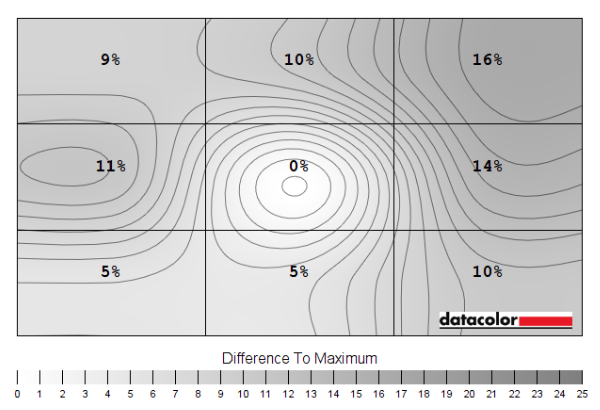
Luminance uniformity map
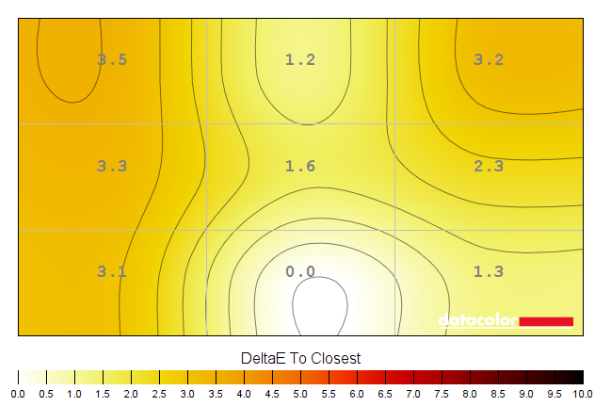
Colour temperature uniformity map
Contrast in games and movies
Lagom contrast tests
Colour reproduction
Colour gamut
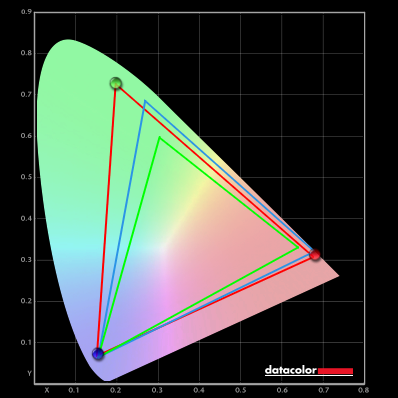
Colour gamut 'Test Settings'
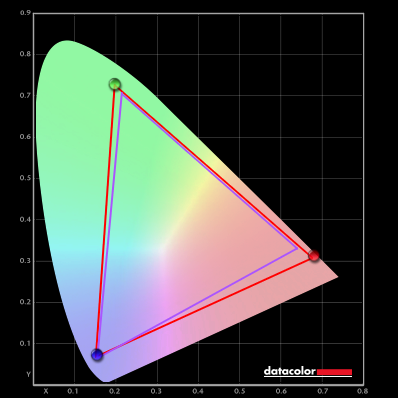
Colour gamut 'Test Settings' vs. Adobe RGB
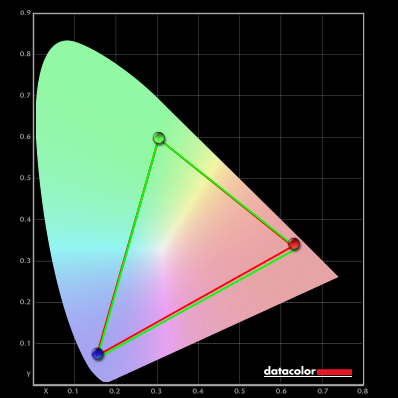
Colour gamut 'sRGB'
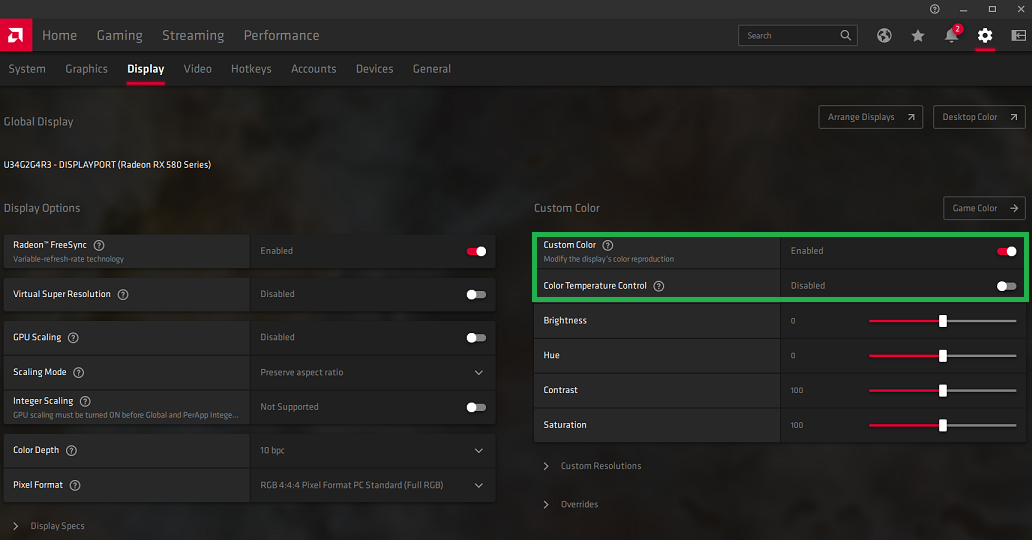
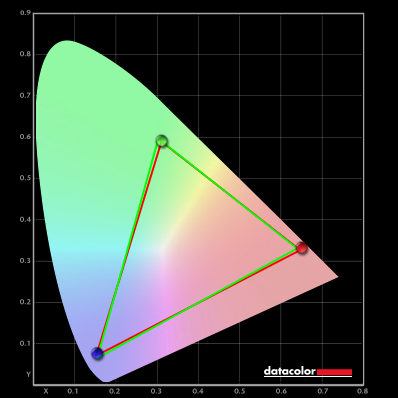
Colour gamut AMD 'CTC disabled' setting
Whilst Nvidia doesn’t have a similar option in their graphics driver, a third party tool called ‘novideo_srgb’ can be used. This provides very similar functionality to the AMD driver option and is a similarly effective GPU-side gamut clamp. The resulting gamut was very similar to that shown above with the AMD tweak – this is expected given it uses the same data from the EDID of the monitor. The tool and its usage is covered in our sRGB emulation article.
Colour in games and movies
Shade representation using SpyderCHECKR 24

The monitor provides a highly saturated and vibrant representation of things. Most shades shown show some degree of oversaturation or appear as a somewhat punchier or ‘neon’ representation of the intended shade. The particularly generous coverage in the green region and green to blue edge of the gamut gives a particularly striking and neon look to dark lime green (18), whilst yellow green (19) looks a bit punchy as well. Cerulean (2), aquamarine (4) and Persian blue (7) are shown in a deeper and more saturated way than intended, too. The generous coverage extends to the red region of the gamut, too, giving a rather lively appearance to candy apple red (14), whilst peach pink (20) and light chocolate brown (24) have their red components brought out too strongly with a red cast. The colour consistency was strong, though, without the clear saturation shifts you’d observe on VA or TN models depending on the on-screen shade position. The disparities between shade representation in this case are related more to slight uniformity issues or slight glare at some points of the screen compared to others. Illuminating the printed sheet appropriately whilst avoiding a bit of glare on the screen itself is challenging. The image below shows how things appear using the sRGB emulation mode (setting ‘Preset’ to ‘sRGB’ in the ‘Picture’ section of the OSD).

The saturation levels are significantly reduced now. We’ve already mentioned some of the imbalances with this setting on our unit as well as the restrictions it imposes. Some shades appear undersaturated now, such as medium orange (3), aquamarine (4), Persian pink (6) and gamboge (23). The red cast to peach pink (20) and light chocolate brown (24) is now diminished, whilst candy apple red (14) appears less neon and more appropriately represented. Dark lime green (18) and yellow green (19) are more faithfully represented now, too. And shades such as lilac (8), Tango pink (11), avocado (12) and grey blue (16) are displayed well. As usual, we’d recommend profiling the monitor with your own colorimeter or spectrophotometer using the native gamut if you require the highest level of colour accuracy.
Viewing angles

The video below shows the Lagom text test, a mixed desktop background, game scene and dark desktop background from a variety of viewing angles. You can see some shifts in contrast and colour for the mixed desktop background and game scene. These shifts are less pronounced than you’d see on TN or VA models but somewhat more pronounced than some IPS-type models with more of a ‘hazing’ effect at sharper viewing angles. The dark desktop background highlights ‘IPS glow’, which creates an obvious ‘bloom’ as viewing angles become steeper. Depending on angle, the glow may take on a coolish silver tint or a warmer and slightly orange tint.
Interlace pattern artifacts
Responsiveness
Input lag
Perceived blur (pursuit photography)

At 60Hz, shown above, the UFO appears relatively broad without clear internal detailing. This reflects a significant degree of perceived blur due to eye movement and is tied to the 60Hz refresh rate. There are also varying degrees of trailing behind the UFOs due to weaknesses in pixel responsiveness. There’s very little in the way of conventional trailing – the ‘Normal’ setting shows a little ‘powdery’ trailing, but nothing substantial. It’s similar to the reference screens in this respect. More so the XB323U GP which shows tighter pixel responses for some transitions than the M27Q, such as behind the yellow UFO cockpit. The ‘Fast’ setting introduces a moderate amount of overshoot, with some colourful and in places quite bright ‘halo’ trailing. It has quite an inky look behind the UFO cockpit for the dark background (top row) with some bright halo trailing behind the UFO body for the medium background (middle row) and to a lesser extent light background (bottom row). The ‘Fastest’ setting ramps this overdrive up to extreme levels, providing extreme overshoot. We consider the ‘Normal’ setting optimal for 60Hz. The pursuit photographs below show how things look with refresh rate doubled, to 120Hz.

At 120Hz, shown above, the UFO now appears significantly narrower with some clearer internal details. This indicates a significant reduction in perceived blur due to eye movement. There are again varying degrees of trailing behind the UFOs due to weaknesses in pixel responsiveness. The ‘Normal’ setting already performs quite well here – better than the M27Q in fact. There’s still a bit of ‘powdery’ trailing visible behind the UFO for the dark and medium backgrounds, which is essentially eliminated for the transitions shown using the ‘Fast’ setting. There is some overshoot using this setting, but substantially less than at 60Hz. This setting performs quite similarly to the XB323U GP, perhaps slightly less aggressive and therefore with slightly lower overshoot. The ‘Fastest’ setting introduces more obvious overshoot. We consider the ‘Fast’ setting optimal for 120Hz. The pursuit photographs below show how things look with refresh rate increased somewhat, to 165Hz. The reference screens run at 170Hz but this makes a negligible difference and therefore the comparison is still valid.

At 165Hz, shown above, the UFO appears a bit narrower again with clearer internal detailing. The pixel response requirements for optimal performance are increased, so the deficiencies of the ‘Normal’ setting become more apparent. This still outperforms the M27Q, which provides more noticeable ‘powdery’ trailing. The ‘Fast’ setting cuts down on this so there’s just a touch of faint ‘powdery’ trailing remaining, for example behind the UFO body of the dark and medium backgrounds. The performance here is similar to the XB323U GP for these transitions, which shows respectable 165Hz tuning by Corsair using this setting. The ‘Fastest’ setting introduces a flare of overshoot, ‘halo’ trailing that’s quite a bit brighter than the background, particularly for the medium and lighter background. Some transitions observed during gameplay show this even more clearly and make this setting rather unattractive in our view. We consider the ‘Fast’ setting optimal at 165Hz.




Responsiveness in games and movies

MPRT (Moving Picture Response Time)
VRR (Variable Refresh Rate) technology
FreeSync – the technology and activating it


The Corsair XENEON supports a variable refresh rate range of 48 – 165Hz (144Hz max via HDMI). That means that if the game is running between 48fps and 165fps, the monitor will adjust its refresh rate to match. When the frame rate rises above 165fps, the monitor will stay at 165Hz and the GPU will respect your selection of ‘VSync on’ or ‘VSync off’ in the graphics driver. With ‘VSync on’ the frame rate will not be allowed to rise above 165fps, at which point VSync activates and imposes the usual associated latency penalty. With ‘VSync off’ the frame rate is free to climb as high as the GPU will output (potentially >165fps). AMD LFC (Low Framerate Compensation) is also supported by this model, which means that the refresh rate will stick to multiples of the frame rate where it falls below the 48Hz (48fps) floor of operation for FreeSync. If a game ran at 28fps, for example, the refresh rate would be 56Hz to help keep tearing and stuttering at bay. LFC sometimes seemed to activate at slightly higher refresh rates, sometimes as high as 53Hz (53fps), but this makes little difference in practice. This feature is used regardless of VSync setting, so it’s only above the ceiling of operation where the VSync setting makes a difference.
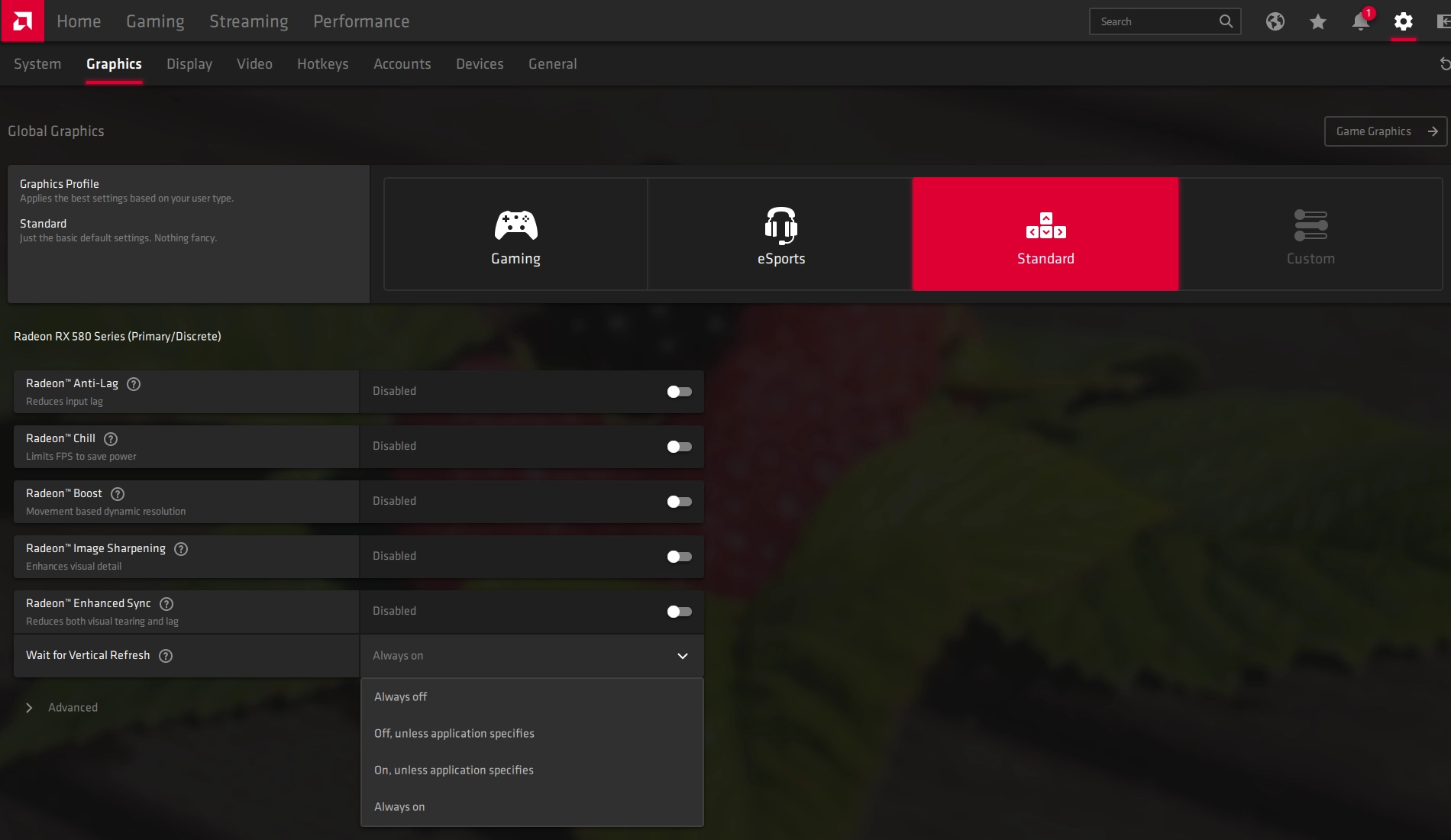
Some users prefer to leave VSync enabled but use a frame rate limiter set a few frames below the maximum supported (e.g. 162fps) instead, avoiding any VSync latency penalty at frame rates near the ceiling of operation or tearing from frame rates rising above the refresh rate. If you activate the ‘Refresh Overlay’ setting in the ‘Picture’ section of the OSD, this will display the refresh rate of the display and therefore indicate the frame rate if ‘FreeSync’ is active and the frame rate is within the variable refresh rate range of the display. The final point to note is that FreeSync only removes stuttering or juddering related to mismatches between frame rate and refresh rate. It can’t compensate for other interruptions to smooth game play, for example network latency or insufficient system memory. Some game engines will also show stuttering (or ‘hitching’) for various other reasons which won’t be eliminated by the technology.
FreeSync – the experience
Nvidia Adaptive-Sync (‘G-SYNC Compatible’)

You will also see in the image above that it states: “Selected Display is not validated as G-SYNC Compatible.” This means Nvidia hasn’t specifically tested and validated the display, not that it won’t work. On our RTX 3090 the experience was very similar to what we described with FreeSync. A slight difference was the floor of operation, which was 55Hz (55fps) with the monitor set to 165Hz and slightly lower if set below that. An LFC-like frame to refresh multiplication technology was employed below that to keep tearing and stuttering from frame and refresh rate mismatches at bay. There was again a very slight momentary stuttering as the boundary was crossed, as we observed with our AMD GPU. And the associated overshoot level change to go with the sudden significant refresh rate change. Our suggestions regarding use of VSync also apply, but you’re using Nvidia Control Panel rather than AMD Radeon Software to control this. The setting is found in ‘Manage 3D settings’ under ‘Vertical sync’, where the final option (‘Fast’) is equivalent to AMD’s ‘Enhanced Sync’ setting. You’ll also notice ‘G-SYNC Compatible’ listed under ‘Monitor Technology’ in this section, as shown below. Make sure this is selected (it should be if you’ve set everything up correctly in ‘Set up G-SYNC’).
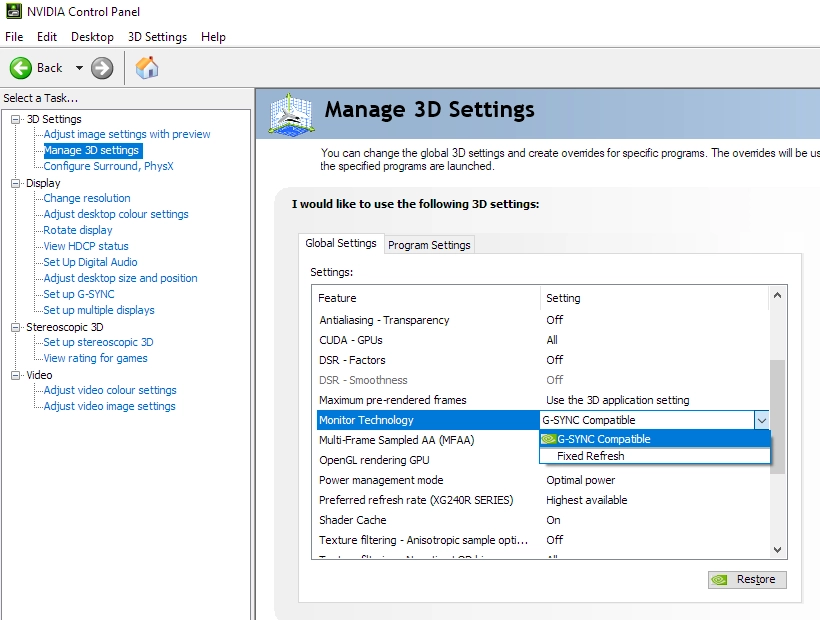
Note again that you can activate the ‘Refresh Overlay’ setting in the ‘Picture’ section of the OSD. This displays the refresh rate of the display and therefore indicates the frame rate if that is within the VRR window (48 – 165Hz). This is a useful indication that the technology is active. And as with AMD FreeSync Premium, HDR can be used at the same time as ‘G-SYNC Compatible Mode’.
HDR (High Dynamic Range)
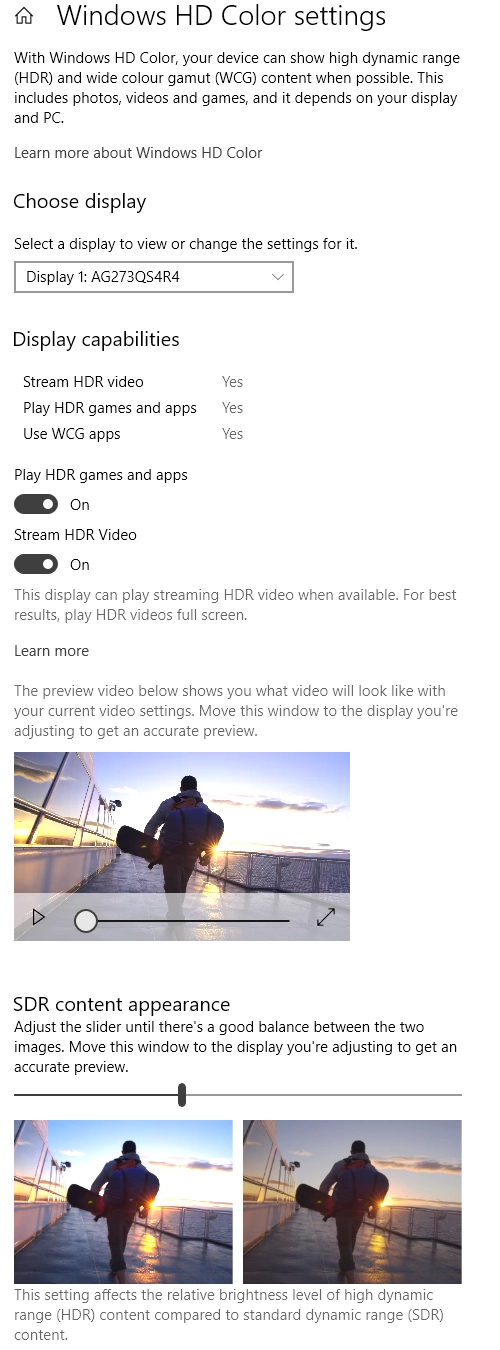

Colour gamut 'Test Settings'
The HDR10 pipeline makes use of 10-bits per colour channel, which the monitor supports via 8-bit + FRC. At some refresh rates (144Hz+ for DP, 120Hz+ for HDMI) the dithering stage is offloaded to the GPU at the native resolution, for bandwidth reasons. We’ve carefully observed a range of content (including fine gradients) on a broad range of monitors where 10-bit is supported monitor side (usually 8-bit + FRC) and where the GPU handles the dithering under HDR. Including comparisons with a given model where the monitor handles the dithering at some refresh rates and the GPU handles it at others. Regardless of how ’10-bit’ is achieved, the result is very similar in the end. It’s possible some subtle differences might be picked up during a careful side by side comparison of very specific content, but the difference is far from clear. The 10-bit colour signal enhances the nuanced shade variety, which helps the monitor put its generous colour gamut to good use. It also aids its display of very closely matching dark shades, lifting out shadow detail in a natural and ‘believable’ way and helping subtle distinctions there. Very different to what some sort of gamma enhancement under SDR might achieve. Brighter shades also benefit, with smoother gradients and more natural shades for weather effects and other fine particle effects, for example. The image below is taken from one of our favourite HDR scenes on Shadow of the Tomb Raider. Remember that the photo is purely for illustrative purposes and in no way represents how the monitor appeared running HDR in person.

The 32″ 2560 x 1440 experience

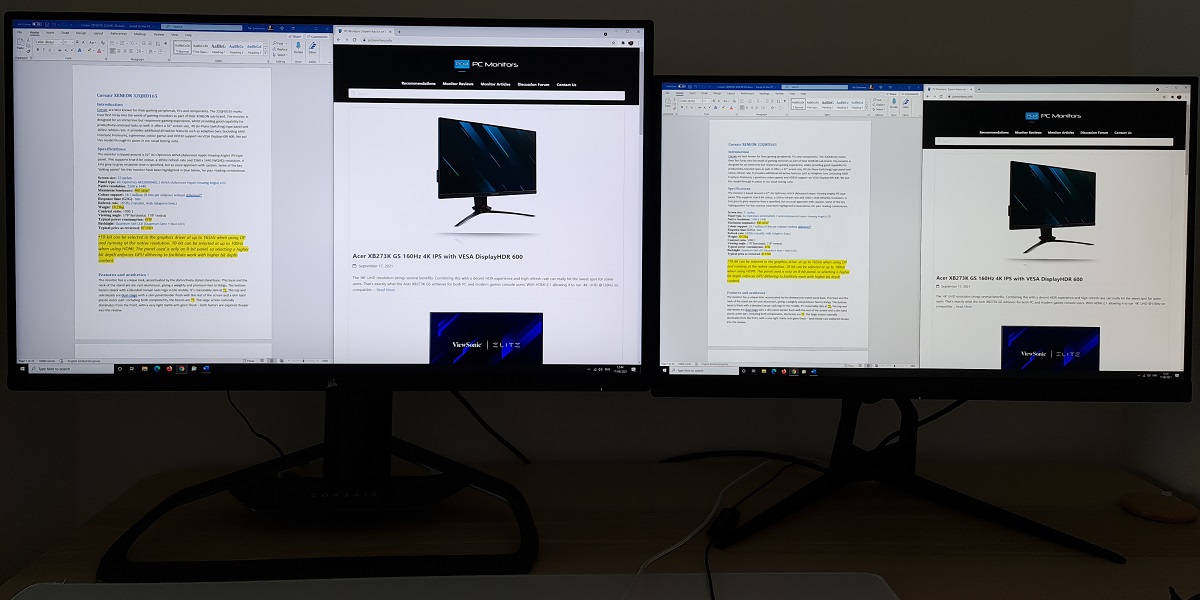
The size also gives you the flexibility to sit a bit further from the screen if you wish, whether for gaming or other tasks. Console gaming or watching movies on a couch or bed, for example. Whilst sitting from our normal viewing position at a desk, we found the gaming experience to be particularly engrossing. We do prefer higher pixel densities ourselves, particularly appreciating ‘4K’ UHD models of this sort of size, but we didn’t find the pixel density ‘poor’ in this case. It’s certainly easier to drive this resolution at high frame rates than on a ‘4K’ UHD screen, even with a powerful GPU such as the RTX 3090 used in our test system. The photos below show a range of game titles running on the monitor. They’re just here to fire up your imagination and don’t accurately represent how the monitor appears in person.

Interpolation and upscaling
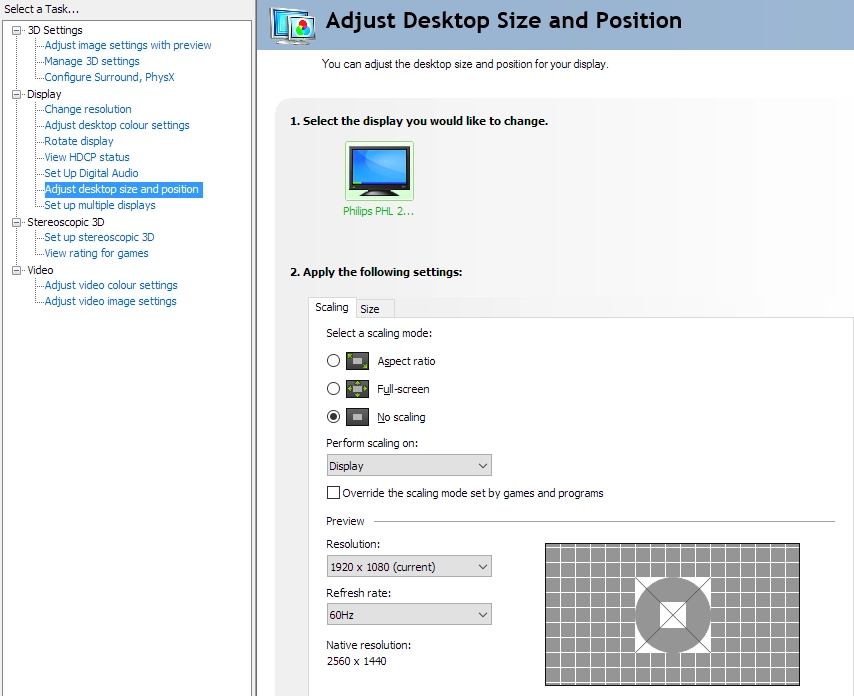
Video review
Timestamps:
Features & Aesthetics
Contrast
Colour reproduction
HDR (High Dynamic Range)
Responsiveness (General)
Responsiveness (VRR)
Conclusion
Positives Negatives Strong colour consistency, highly vibrant colour output due to gamut (appropriate for HDR) and sRGB emulation with adjustable brightness
sRGB emulation not particularly flexible or well-tuned (GPU-level methods may be preferred), no Adobe RGB or DCI-P3 emulation with extension beyond both gamuts natively Very light matte screen surface provides fairly direct light emission without clear layering or strong graininess Moderate ‘IPS glow’, though slightly lower than some models of the size still certainly a feature. Fairly unimpressive brightness for HDR and no local dimming Good 165Hz pixel response performance without major weaknesses, low input lag and VRR working as expected with AMD and Nvidia GPUs No variable overdrive – moderate overshoot as refresh rate dips unless ‘Response Time’ setting reduced Good ergonomic flexibility, very solid stand and an immersive experience with good ‘desktop real estate’ Pixel density decent though not particularly high – unlike the price, which is high for the specification and feature set







